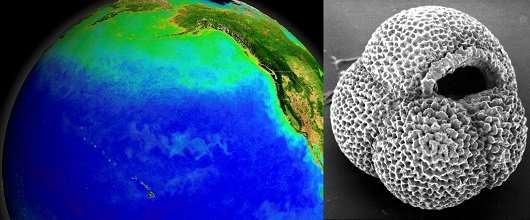About 15,000 years ago, changes in ocean circulation caused the North Pacific Ocean to discharge copious amounts of CO2 into the atmosphere, thereby warming the planet and sealing the end of the last Ice Age. The findings could prove highly important for managing and mitigating current climate change trends.

Researchers studied the chemical composition of the fossilized shells of a type of plankton called foraminifera — some of the most abundant shelled organisms in many marine environments. This allowed British scientists at the University of St Andrews to reconstruct the exchange of CO2 between the North Pacific Ocean and the atmosphere. The analysis showed that around the end of the last Ice Age, the North Pacific released large amounts of CO2 during a time when the Atlantic ocean’s currents were rapidly changing.
The shift in ocean circulation not only explains the considerable release of CO2 by the North Pacific, which eventually helped end the Ice Age by warming the entire planet, but also the drop in oxygen levels in the Pacific Ocean seen at the time and first observed nearly two decades ago.
The findings have huge implications for climate research today. Just last week, scientists at the University College London reported that the Atlantic’s circulation is at its weakest point in 1,600 years, a trend that could disrupt weather patterns all the way from the United States to the African Sahel. The 15% slowdown, compared to peak circulation, is equivalent to three million cubic meters of water per second — water movement that is connected to fish stocks, industry and weather systems.
The link between ocean currents and very rapid changes in the climate, identified by the new study, gives us an example of just how intricately connected different parts of the climate system can be. In other words, “changes in circulation in one region can drive changes in CO2 and oxygen all the way over on the other side of the planet,” said Dr. Will Gray, lead author of the new study and a researcher at the School of Earth and Environmental Sciences, University of St Andrews.
“The North Pacific Ocean is very big and just below the surface the waters are brimming with CO2; because of this, we really need to understand how this region can change in the future, and looking into the past is a good way to do that,” Gray added.
Co-author Dr. James Rae, also from the University of St Andrews, added: “Although the CO2 rise caused by this process was dramatic in geological terms, it happened very slowly compared to modern man-made CO2 rise. Humans have driven CO2 rise in the atmosphere as large as the CO2 rise that helped end the last Ice Age, but the man-made CO2 rise has happened 100 times faster. This will have a huge effect on the climate system, and one that we are only just beginning to see.”
Scientific reference: William R. Gray et al. Deglacial upwelling, productivity and CO2 outgassing in the North Pacific Ocean, Nature Geoscience (2018). DOI: 10.1038/s41561-018-0108-6.


